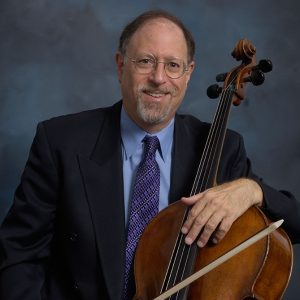
The Joy of Feuillard – A Sequential Approach to Teaching Bow Technique (Part 5 – Feuillard #32 – Theme and Variations 1-3)
Robert Jesselson
Part 5 – Feuillard #32 – Theme and Variations 1-3
Now we are ready to start working on the Feuillard bowing exercises themselves. I usually begin explaining how to approach the Theme and Variations in the very first lesson. But since most of the time in the first lesson is taken with all the necessary “preliminary” information about the bow (as discussed in Blogs 3 and 4), and with basic information about the scale/arpeggio system and etudes, there will be just a brief introduction to the Feuillard project in that initial lesson.
First I explain to the students how these Feuillard exercises are organized, with a theme and then a set of variations.
Theme of No. 32:
 Theme from Lesson 1:
Theme from Lesson 1:
Then I explain to them how we check for intonation using the perfect intervals. Since the students will be playing the same notes again and again, this is a great way to instill good intonation – if they are careful about checking first position. They will be training both their ears and their hands. But first they have to have a basic understanding of the intervals.
Intervals:
Next we go over how to check first position, using these perfect intervals, so that the students are cognizant of the hand position and basic intonation as they repeat the theme over and over in all its variations. The key to this is that we check the first and fourth fingers of the left hand in order to establish the basic outline of the hand. For most people the first finger tends to get sharp and the fourth finger tends to be flat. By checking with the perfect intervals they can organize the structure of the hand. Later we will address the middle fingers.
Checking First Position:
So the basic rule for checking first position is:
Check the first finger with the string above and get a Perfect 4th.
Check the fourth finger with the string below and get a Perfect 8th (Octave)
Now we are ready to play the full theme, paying attention to the basic intonation and getting a good sound. After a few attempts, with lots of checking, the intonation for the Theme becomes more stabile and the sound is better. At this point I need to explain to the student how the variations are going to work, with the directions for which part of the bow to use written under each variation, and the articulation written above the notes. I need to make sure that they understand the abbreviations with the explanation key at the top of the page. And I need to make sure that they understand that each variation will have a different tempo and style.
How the Variations Work:
By the second lesson, Caroline has understood and internalized most of these preliminary instructions. She knows how to check first position, has practiced the Theme and she has found a good tempo for Variation 1 – which takes some experimentation. She is using left-right motion and is getting a better “core” sound and “block of sound” than she had in the previous week – all without prompts from me. So we are now ready to start going through the variations and figuring out how to control the bow.
Variation #1:

The tempo for Variation 1 should be thought of in the 8th note, rather than the quarter note because otherwise it will be too fast to play this variation using a full bow on the lower strings. I suggest a tempo of about 8th note = 72 or so.
For most of the video examples in this blog I will not present the student’s entire performance of the whole variation to save time and space here. However I feel that it is very important that they play each variation in its entirety in the lessons. I treat these as “performances”. If there are too many “blips” in the lesson performance, or if they do not understand the technical issues involved, then they have to repeat the variation the following week. A variation will be “passed off” only if it is done accurately, with good sound and good intonation.
Feulliard #32 Variation 1
Variation #2:

This Variation should be executed in two different ways: one way is with a high contact point (close to fingerboard) and a fast bow speed with the bow staying on the string. The second way is with a low contact point (close to the bridge) and a short amount of bow, but lifting the bow above the string and bringing it to the tip in the air. Use a similar tempo to Variation #1, thinking in the 8th note rather than the quarter note. It is important to do the left/right motion in order to get to the tip easier. The student is practicing coordination with the left/right motion, and also figuring out one of the important body movements that make playing easier and more communicative. It is like learning the choreography of playing the cello.
Usually I explain new concepts in one lesson, and then ask the student to practice the variation remembering these new concepts. Then, when the student comes back the next week I check to make sure that they not only can play the variation, but that they remember the concepts.
Feulliard #32 Variation 2:
The teacher must always evaluate wether it is more important to stay on a variation to “perfect” it, or to move on and address a particular technical issue in a later variation. This will depend on each individual student’s ability, personality, the amount of time it takes to get the main concepts, etc. In this case, although the staccato sound was not “perfect”, it was good enough for the moment. We will be addressing the sound more in upcoming staccato variations.
Variation #3:

Variation #3 has four notes in a bow. To get a good sound on this variation requires having a contact point close to the bridge. The “rule” is” The more notes in a bow, the lower the contact point.
Feuilliard #32 Variation 3:
I usually ask the student to prepare about 10 variations for the next lesson – writing in the tempo for each variation, and trying to figure out what the main “issues” are for each variation. They should be able to verbalize what it is that they are trying to do. By telling me in words what the goal is they are not only re-enforcing the information, but they are using a different part of the brain to clarify what they are doing. It is good if they can play something, but it is even better if they can tell me what the issues are and execute them well.
The next Blog will explore the next several variations, which will include staccato strokes, bow distribution, dotted rhythms, and various combinations of these tasks.
*If you have questions or comments about The Joy of Feuillard, Dr. Robert Jesselson can be reached directly at rjesselson@mozart.sc.edu.
Subjects: Repertoire, Technique
